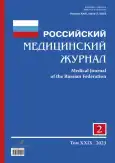Results of monitoring diabetic retinopathy in patients after simultaneous pancreas and kidney transplantation
- Authors: Vorobyeva I.V.1,2, Bulava E.V.1, Balkarov A.G.3,4,5, Dmitriev I.V.3,4
-
Affiliations:
- Russian Medical Academy of Continuous Professional Education
- RUDN University
- N.V. Sklifosovsky Research Institute for Emergency Medicine
- N.I. Pirogov Russian National Research Medical University
- Research Institute of Public Health Organization and Medical Management
- Issue: Vol 29, No 2 (2023)
- Pages: 106-115
- Section: Original Research Articles
- Submitted: 23.03.2023
- Accepted: 31.03.2023
- Published: 28.04.2023
- URL: https://medjrf.com/0869-2106/article/view/321577
- DOI: https://doi.org/10.17816/medjrf321577
- ID: 321577
Cite item
Abstract
BACKGROUND: Very few studies have focused on the state of the fundus and visual functions before and after simultaneous transplantation of the pancreas and kidney. In addition, the results and conclusions of authors on this topic are contradictory.
AIMS: To evaluate the ophthalmological status of patients with diabetic retinopathy before and after kidney and pancreas transplantation.
MATERIALS AND METHODS: The patients were divided into three groups: group 1 included patients on the transplant waiting list receiving hemodialysis, group 2 were kidney transplant recipients, and group 3 included patients who had undergone simultaneous pancreas and kidney transplantation. The ophthalmological status of patients was assessed through standard ophthalmic diagnostic methods and measurements of photosensitivity, central retinal thickness, choroid thickness, density perfusion of the superficial and deep retinal capillary plexus, choriocapillary layer, and deep choroidal layer in the foveal and parafoveal zones of the macular region.
RESULTS: The study involved 76 patients (152 eyes) (group 1, n=30 patients undergoing dialysis; group 2, n=24 kidney transplant recipients; group 3, n=22 kidney and pancreaticoduodenal post-transplant recipients). Signs of the active phase of the proliferative stage of diabetic retinopathy (group 1, 54.1%; group 2, 53.3%; and group 3, 25.9%, p <0.05) and diabetic macular edema (group 1, 26.4%; group 2, 31.8%; and group 3, 12.8%, p <0.05) were more common in groups 1 and 2 than in group 3. Moreover, group 3 needed laser therapy (group 1, 45.3%; group 2, 43.2%; and group 3, 20.5%, p <0.05) and antiangiogenic therapy to a lesser extent (group 1, 18.9%; group 2, 25.0%; and group 3, 5.1%, p <0.05) than patients undergoing dialysis and kidney recipients. The eyes of patients after simultaneous pancreas and kidney transplantation were characterized by the smallest retinal thickness, highest retinal and choroidal perfusion, and highest visual acuity and photosensitivity (p <0.05).
CONCLUSIONS: A surgical method for restoring euglycemia through transplantation of physiologically active pancreatic tissue favorably affects the morphological and histological state of the retina and retinal and choroidal hemoperfusion and reduces the frequency of the active phase of proliferative diabetic retinopathy and diabetic macular edema.
Full Text
About the authors
Irina V. Vorobyeva
Russian Medical Academy of Continuous Professional Education; RUDN University
Email: irina.docent2000@mail.ru
ORCID iD: 0000-0003-2707-8417
SPIN-code: 1693-3019
MD, Dr. Sci. (Med.)
Russian Federation, 2/1 Barrikadnaya street, 123242 Moscow; MoscowEvgeniy V. Bulava
Russian Medical Academy of Continuous Professional Education
Email: bulava.eyes@gmail.com
ORCID iD: 0000-0002-7201-3885
SPIN-code: 1601-9710
PhD student
Russian Federation, 2/1 Barrikadnaya street, 123242 MoscowAslan G. Balkarov
N.V. Sklifosovsky Research Institute for Emergency Medicine; N.I. Pirogov Russian National Research Medical University; Research Institute of Public Health Organization and Medical Management
Email: balkarov_a@mail.ru
ORCID iD: 0000-0002-1396-7048
SPIN-code: 4649-0045
MD, Cand. Sci. (Med.)
Russian Federation, 2/1 Barrikadnaya street, 123242 Moscow; Moscow; MoscowIlya V. Dmitriev
N.V. Sklifosovsky Research Institute for Emergency Medicine; N.I. Pirogov Russian National Research Medical University
Author for correspondence.
Email: ildmi@mail.ru
ORCID iD: 0000-0002-5731-3310
SPIN-code: 3916-6591
MD, Cand. Sci. (Med.)
Russian Federation, 2/1 Barrikadnaya street, 123242 Moscow; MoscowReferences
- Barnett R. Type 1 diabetes. Lancet. 2018;391(10117):195. doi: 10.1016/S0140-6736(18)30024-2
- Chaudhary S, Zaveri J, Becker N. Proliferative diabetic retinopathy (PDR). Dis Mon. 2021;67(5):101140. doi: 10.1016/j.disamonth.2021.101140
- Tung CW, Hsu YC, Shih YH, et al. Glomerular mesangial cell and podocyte injuries in diabetic nephropathy. Nephrology (Carlton). 2018;23(4):32–37. doi: 10.1111/nep.13451
- Kukla A., Ventura-Aguiar P., Cooper M., et al. Transplant options for patients with diabetes and advanced kidney disease: a review. Am J Kidney Dis. 2021;78(3):418–428. doi: 10.1053/j.ajkd.2021.02.339
- Rajkumar T, Mazid S, Vucak-Dzumhur M, et al. Health-related quality of life following kidney and simultaneous pancreas kidney transplantation. Nephrology (Carlton). 2019;24(9):975–982. doi: 10.1111/nep.13523
- Lange UG, Rademacher S, Zirnstein B, et al. Cardiovascular outcomes after simultaneous pancreas kidney transplantation compared to kidney transplantation alone: a propensity score matching analysis. BMC Nephrol. 2021;22(1):347. doi: 10.1186/s12882-021-02522-8
- Sucher R, Rademacher S, Jahn N, et al. Effects of simultaneous pancreas-kidney transplantation and kidney transplantation alone on the outcome of peripheral vascular diseases. BMC Nephrol. 2019;20(1):453. doi: 10.1186/s12882-019-1649-7
- Giannarelli R, Coppelli A, Sartini M, et al. Effects of pancreas-kidney transplantation on diabetic retinopathy. Transpl Int. 2005; 18(5):619–622. doi: 10.1111/j.1432-2277.2005.00108.x
- Pearce IA, Ilango B, Sells RA, Wong D. Stabilisation of diabetic retinopathy following simultaneous pancreas and kidney transplant. Br J Ophthalmol. 2000;84(7):736–740. doi: 10.1136/bjo.84.7.736
- Voglová B, Hladíková Z, Nemétová L, et al. Early worsening of diabetic retinopathy after simultaneous pancreas and kidney transplantation-Myth or reality? Am J Transplant. 2020;10:2832–2841. doi: 10.1111/ajt.15924
- Tsai FY, Lau LI, Li AF, et al. Acute macular edema and peripapillary soft exudate after pancreas transplantation with accelerated progression of diabetic retinopathy. J Chin Med Assoc. 2017. Vol. 80, N 5. P. 319–325. doi: 10.1016/j.jcma.2017.01.004
- Koznarová R, Saudek F, Sosna T, et al. Beneficial effect of pancreas and kidney transplantation on advanced diabetic retinopathy. Cell Transplant. 2000;9(6):903–908. doi: 10.1177/096368970000900617
- Abendroth D, Schmand J, Landgraf R, et al. Diabetic microangiopathy in type 1 (insulin-dependent) diabetic patients after successful pancreatic and kidney or solitary kidney transplantation. Diabetologia. 1991;34 Suppl. 1:S131–S134. doi: 10.1007/BF00587639
Supplementary files









